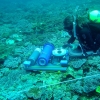Lessons from the Sea
Researchers travel to remote atoll to study nature of coral survival
Coral reefs are among the most biologically diverse and economically valuable ecosystems on Earth. They supply food for millions; protect coastlines from storms and erosion; provide jobs based on fishing, recreation and tourism; and serve as a source for new medicines.
These precious natural resources around the world are being affected by rising sea levels, warmer temperatures and increasing acidity in our oceans. Understanding how this sensitive living organism adapts, or doesn’t, to variables in its marine environment could help scientists determine ways to protect coral reefs from climate change.
UC Irvine civil and environmental engineer Kristen Davis led a recent field expedition to a remote coral reef ecosystem near Taiwan in the South China Sea to investigate the interaction between the area’s unique ocean environment and the corals and algae that comprise the reef.
Designated as a Marine National Park and a protected area, the Dongsha Atoll is a rare example of an intact atoll, a circular coral reef enclosing a shallow lagoon. Managed by the Taiwanese Coast Guard, the atoll has a small island at one end with a research station. Access is by boat or a weekly military flight from Taiwan.
Davis, who uses fluid mechanics principles to study ocean processes that affect marine ecosystems, has studied water circulation around coral reefs in the Florida Keys, Red Sea and Gulf of Aqaba. “I’m trying to determine what strategies corals use to survive in places where there are lots of changes to the physical environment,” she says. This information could help us understand how they’ll react to future climate-driven changes in the ocean.”
As home to some of the world’s largest internal waves, the Dongsha Atoll experiences plenty of natural variability. Internal waves are made of deep, cold, dense water rising into layers of shallower, warmer, lighter water. The differences in density cause the many layers to behave like different fluids. The interaction of tidal currents with the unique topography of the South China Sea floor produces massive internal waves. They can be a thousand times larger than the more familiar surface waves, and they can last several hours.
Davis’ research aims to determine how the corals are affected by these underwater waves, which bring cool, nutrient-rich and lower oxygen seawater to the shallow coral communities. “Exposure to this water may enhance coral nutrition and help buffer the corals from heat-induced bleaching,” she explains. Bleaching occurs when the symbiotic algae, which live on coral and provide its nutrients, is expelled. Sometimes coral will recover and attract new algae; if not, it dies.
Serving as one of the lead scientists, Davis oversaw a group of nine researchers from the U.S. and Taiwan in the month-long research expedition to the atoll. She was one of three certified scuba divers who placed instruments in and around the reef and lagoon and took samples of water and coral. They deployed a myriad of sensors to measure temperature, oxygen, pressure, currents, salinity and pH in the water.
Because most of the reef is underwater, the team constructed a scaffolding tower on the reef platform to serve as a base for equipment and solar panels that powered their work.
The team also laid 4 km of fiber optic cable on the sea floor, from the lagoon over the reef and out toward the ocean. With a technology called distributed temperature sensing (DTS), this cable collected temperatures every meter at 30-second intervals, allowing the researchers to track the cold water carried to the reef by the internal waves. Originally developed for industrial use in the oil industry, DTS records a continuous profile of temperatures. In this case, it cheaply and effectively measured water temperature over a vast distance, using the same type of cable that plugs into a phone or television.
“This was a relatively new application for this technology, and it was extremely successful,” says Davis.
UCI engineering graduate student Aryan Safaie spent two months prior to departure learning how to use all the instruments (DTS technology, four types of temperature sensors, four current meters, four oxygen and three pH sensors). He helped prepare and program all of the equipment and downloaded the data at the expedition’s end.
Not a diver, Safaie spent most of his time on the boat. It was his first field experience, and the Southern Californian deemed it a “crucial, important and much-appreciated learning experience, but also very difficult. It was like ‘bizarro’ summer camp. The living conditions were tricky, the food was terrible, and the mosquitoes, rats and big spiders were a bit too comfortable with humans.”
Safaie adds that the people were wonderful – incredibly friendly and hospitable. “The Coast Guard and Marine Park staff took us in like family. We stayed up late and exchanged stories.”
Both Safaie and Davis are glad to be home and look forward to analyzing the data.
“Internal waves potentially make Dongsha Atoll a unique coral reef, well-suited to being resistant to the effects of climate change and ocean acidification,” says Davis. “Once we understand the science of how coral survives, we can determine how to help or remove stressors.”
- Lori Brandt

